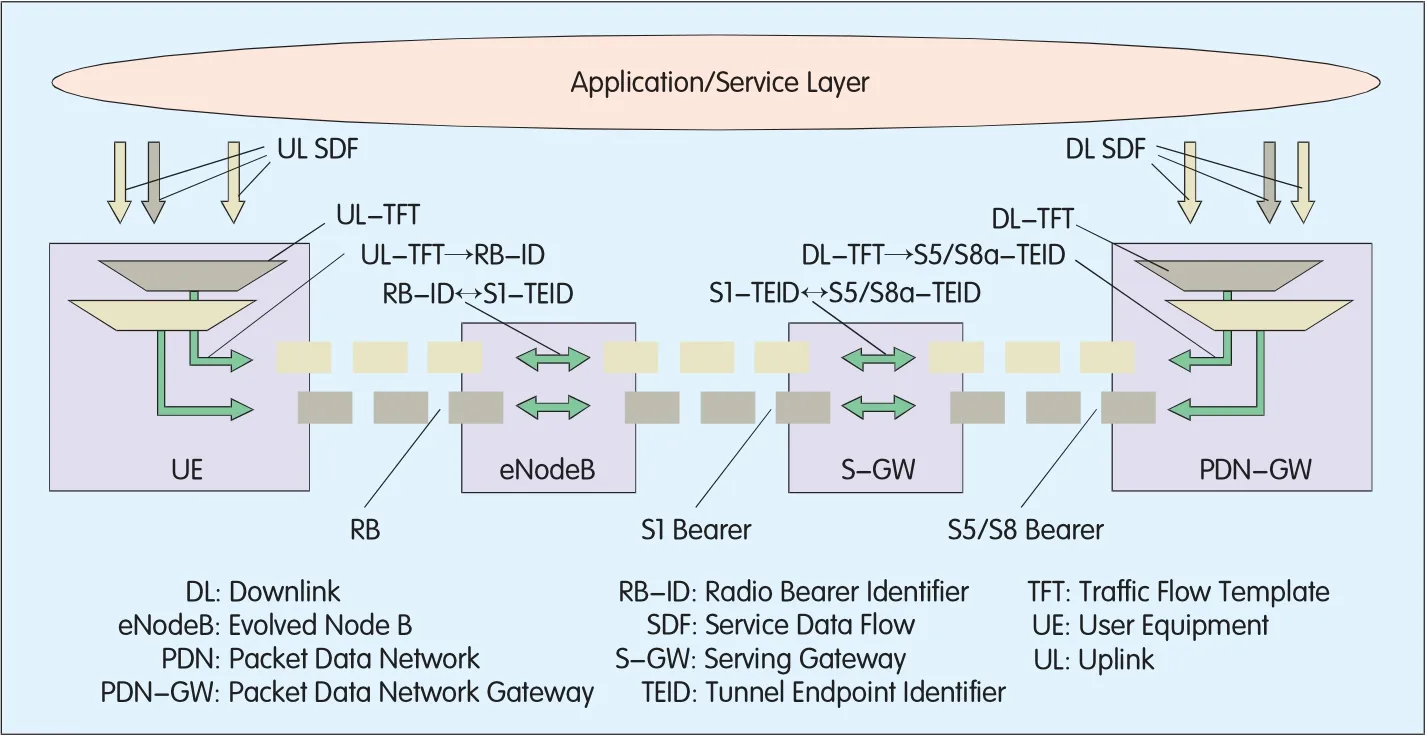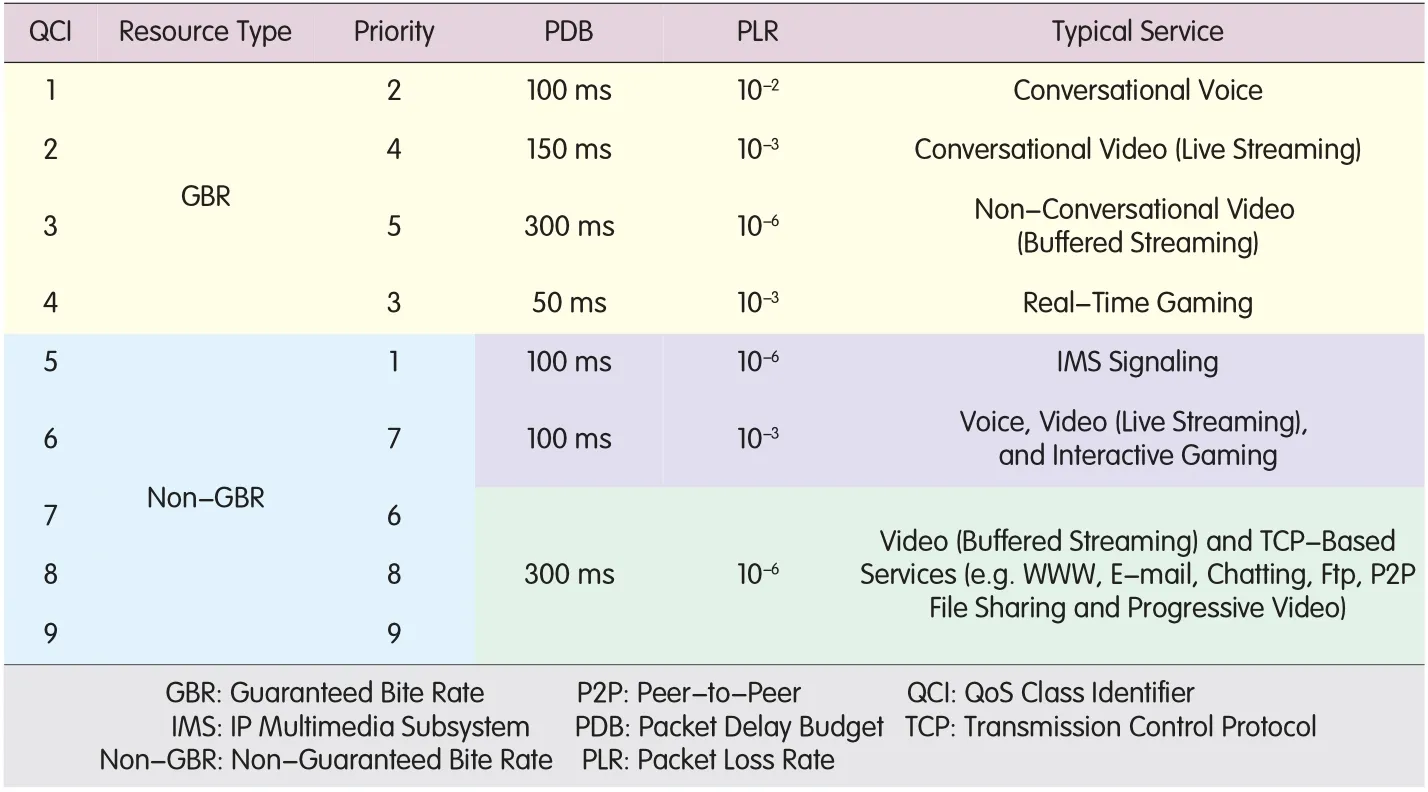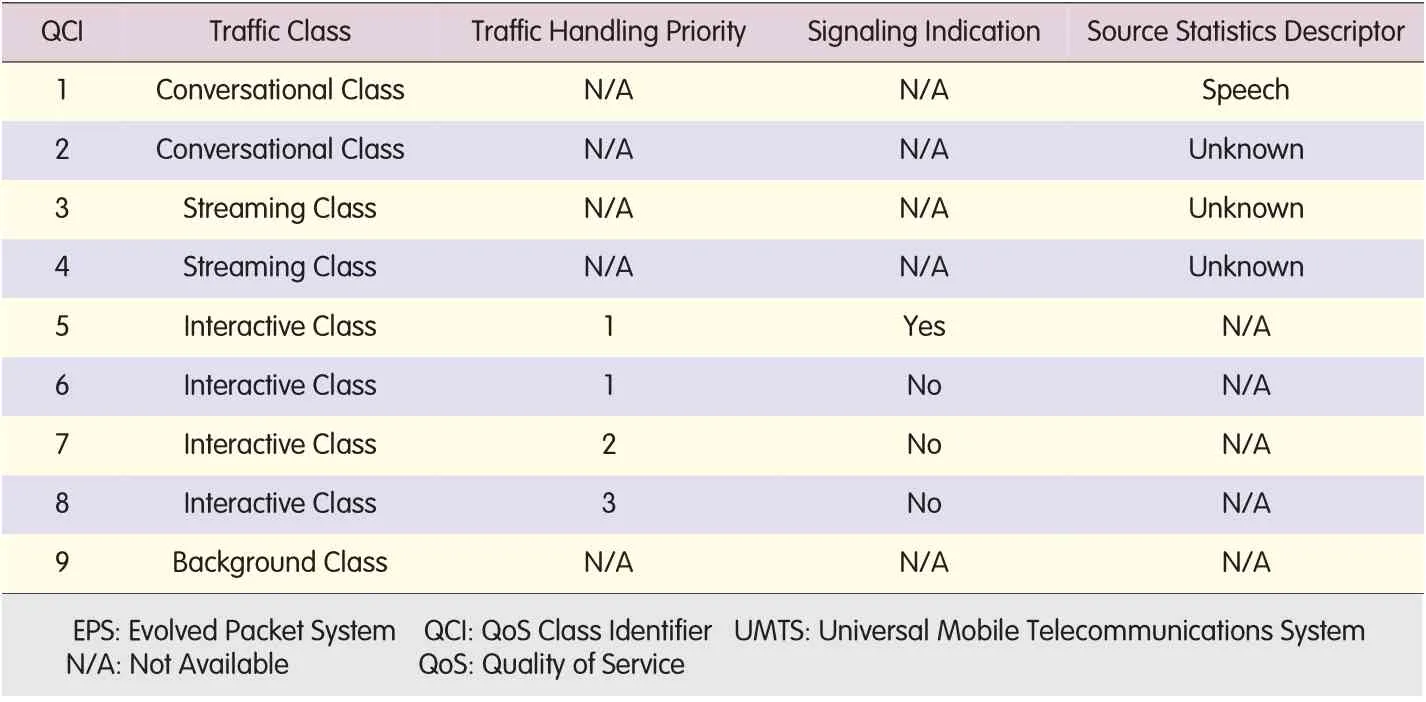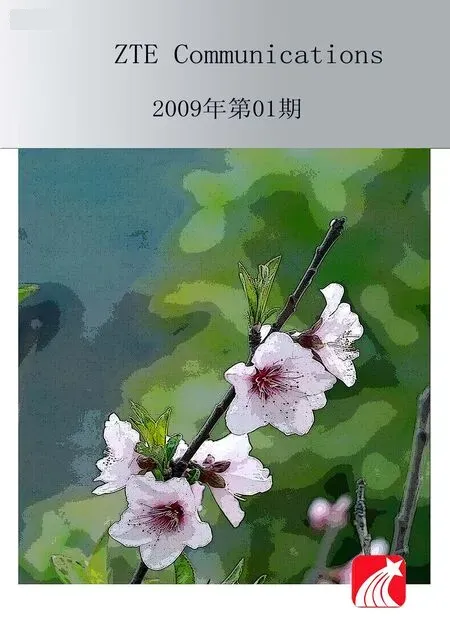QoSMechanism in EPS
Huang Tao,Zhang Zhijiang,Liu Yunjie
(China Unicom Co. Ltd., Beijing 100140, P. R. China)
Abstract:To adap t to the development of m obile communication technolog ies in the next 10-year timeframe and better meet an ever-inc reasing demand for data services,3GPP has started the Long Term Evolution(LTE)and System Architecture Evolution(SAE)study p rojects.In view of the high-speed and bursty feature of future data services,the Evolved Packet System(EPS)makes quite a few enhancements and imp rovem ents in Quality o f Service(QoS).By introducing such technologies as default bearer and agg regate resource schedu ling,the EPS truly realizes the ob jec tive of"Always Online"for users,imp roves data rates and thus enhances user experience ultimately.Furtherm ore,an app rop riate mapping between the EPS QoS Class Identifier(QCI)param eter and Universal Mobile Telecommunication System(UMTS)QoS parameter is designed regard ing future interoperability scenario between UMTS Terrestrial Radio Access Network(UTRAN)and Evolved UTRAN(E-UTRAN).
A tp resent,one of themajor challenges confronted by the mobile communication system is to delivervarious types of multimedia services inc lud ing data,voice,image and video w ith guaranteed Quality ofService(QoS)[1].To guarantee QoS ofvariousmultimedia services,3GPP c learly defines the end-to-end QoS architecture for UniversalMobile Telecommunication System(UMTS),and introduces severalbearerand p rocessing mechanisms to ensure UMTS canmake fullof its technicaladvantages to offerd ifferentiated services forusers.
To keep the competitive advantages of3GPP systems in the next10-year timeframe and better support the ever-inc reasing demand ofusers for data services,3GPP launched the Long Term Evolution(LTE)and System Architecture Evolution(SAE)study p rojec ts[2]in 2004.The SAE p rojec taims atop tim izing and enhancing system performance in term s ofnetwork architecture,and the evolved network is called Evolved PacketSystem(EPS).
The QoSmechanism for EPShas made quite a few enhancements and im p rovements on the basis ofUMTS.
Firstly,in view of the high-speed and bursty feature of future data services,the EPS introduces the concep tofdefault bearer to effectively enhance user experience,reduce service setup latency and truly realize"Always Online".A defaultbearerw ith a constantdata rate is estab lished fora userwhen the user attaches to a network in order to ensure the user's basic service requirements aremet.
Second ly,the LTE uses shared channelmechanism to rep lace the ded icated channelin Rad io Access Network(RAN),and adop tsmore flexib le dynam ic scheduling technology.Corresponding ly,the EPSgives up com p licated QoS negotiationmechanism for UMTS.
In addition,the EPSnetworks are required to enab le various Rad io Access Technologies(RATs),such as GSM,Wideband Code Division Multip le Access(WCDMA),LTE,CDMA2000 and Worldw ide Interoperability forMic rowave Access(WiMAX),to access a uniform packet-domain core network.According ly,the EPSmustalso support end-to-end QoSguarantee forusers crossing d ifferentaccess networks,that is,User Equipment(UE)crossing access networks can fulfillmapp ing between the QoS parameters in order to ensure seam less userexperience[3].
1 Evolution of QoS in 3GPP Mobile Networks
With the convergence ofw ireless communication technologies and IP technologies,themobile communication networks have evolved from GSM network to GeneralPacketRad io Service(GPRS)network and to p resentUMTS network capab le ofoffering high-speed real-time data services.Follow ing the evolution footsteps ofmobile networks,the QoSmechanism also g radually comes tomaturity in order to p rovide satisfying services forusers based on various service features.
The GSM network is based on Circuit Sw itch(CS),and QoS is guaranteed once a circuitconnection is estab lished.According ly,QoS guarantee is quite simp le and QoS parameters are basically not transferred in the GSM network.
The introduc tion of the IP bearer makes the GPRS network based Packet-Switched(PS)have farmore com p licated QoS guaranteemechanism than the GSM network.GPRS defines the follow ing QoS parameters:latency level,reliability,maximum data traffic,p riority,average data traffic,and retransm ission request.These QoS parameters are required to be transferred between UE and such network-side entities as the Serving GPRSSupportNode(SGSN)and Gateway GRRSSupportNode(GGSN).

▲Figure 1. EPS bearer service architecture.
End-to-end QoS hierarchical architecture is introduced in R99.This architecture involves allNetwork Elements(NEs),inc luding UE,radio access network entities and core network entities,and requires consistentQoS parameter p rocessing on d ifferent interfaces.The end-to-end QoS hierarchicalarchitec ture introduced in UMTS is a g reat leap forward on the road ofQoS evolution formobile communication networks[4].Furthermore,the core network IP bearer in R99 adop ts the QoS technologies defined by IETF,inc lud ing Integ rated Services(IntServ)/Resource Reservation Protocol(RSVP),Multi-ProtocolLabelSw itch(MPLS),Differentiated Services(DiffServ),Traffic Engineering(TE)and constraint-based routing.R99,for the first time,c learly defines fourservice typesw ith differentQoS:Conversational,Stream ing,Interactive and Backg round.
To fulfillend-to-end QoS guarantee for IPMultimed ia System(IMS)services,3GPP p roposed an IP-connection based Policy Decision Function(PDF)in R5/R6[5].In the subsequentR7,the PDF and Flow Based Charging(FBC)specified in R6 were then combined,and the Policy and Charging Control(PCC)subsystem is added between the service control layerand the access/bearer layer to imp lement resource adm ission control function.Considering the strong bursty feature of future data services,R8 introduces EPS dedicated and default bearers to effec tively m inim ize bearer setup latency and truly realize"Always Online"forusers[6].In addition,the comp licated QoSnegotiationmechanism is elim inated in the bearing p rocesses(bearersetup/modification/deletion)in the EPS network due to the channelsharing mechanism on LTERAN.
2 QoS Mechanism in EPS
A bearer is the basic levelofQoS control g ranularity in R8 EPS,thatis,alldata traffic on the same bearerare g ranted identicalQoS guarantee and various types ofQoSguarantee are p rovided for d ifferentbearers.The bearermechanism for EPS is different from that for UMTS in the follow ing aspects:
(1)EPS bearers are used to rep lace PacketData Protocol(PDP)contexts.An EPSbearer can be deemed as a logical circuitbetween UE and PacketData Network Gateway(PDN-GW).
(2)A defaultbearer is setup according to the subscribed defaultQoS c lass in the p rocess ofa user's initial attachment to the network,that is,each UE has at leastone ac tive bearer to shorten latency taking p lace during service initiation.
(3)The PDP contextsetup p rocedure initiated by term inalchanges into the data bearer setup p rocedure triggered by the network side;the triggering conditions are various,inc luding interaction between Policy and Charging Rules Function(PCRF)entities in IMS session,Mobility ManagementEntity(MME)indication during initial attachment,and UE request,so as to facilitate QoS and policy controlof the services initiated by the network side in the future.
(4)EPSQoSmechanism is im p lemented based on the QCI parameter,which can be used to supersede overa dozen ofparameters in UMTS,that is,the evolved NodeB(eNodeB)can deduce allparameter features from QCI.
2.1 EPS Bearer Service Architecture
EPS estab lishes and adop ts the bearer service w ith c learly defined attributes and functions from the start to the end of a service to realize end-to-end QoS.Figure 1 shows the hierarchicalstructure of the EPS bearerservice:
The EPS bearerservice architecture,as shown in Figure 1,has the sim ilar hierarchicaland region-based QoS frameworkw ith that in UMTS network,that is,the bearerservice ofeach layer is offered through the bearerservice of the layer immed iately below it[7-8].
The end-to-end QoS service consists of the externalbearer service and the EPS bearer service.The former is used to carry outservices between the UMTS core network and externalnetwork nodes;and the latter is further subd ivided into the EPSRad io Bearer(RB)service and the EPSAccess Bearer(AB)service.
The EPSRB service imp lements the transportofEPS bearerservice data units between eNodeB and UE accord ing to requested QoS.Moreover,it supports IP header com p ression and user p lane encryp tion func tions,and p rovidesmapping and multip lexing information forUEs.
EPSAB services im p lement the transportofEPS bearerservice data units between MMEand eNodeB based on requested QoS,and p rovide QoS guarantee forend-to-end IP traffic flow convergence[9].
2.2 Concept of EPS Bearer
EPS defines a PacketData Network(PDN)connec tion service as an IP connec tion between a UEand an externalPDN of the Pub lic Land Mobile Network(PLMN).The PDN connection service is ab le to support the transm ission ofone ormore Service Data Flows(SDFs).
When the S5/S8 interface between a Serving Gateway(S-GW)and a PDN Gateway(PDN-GW)is based on GPRS TunnelProtocols(GTP),the PDN connection service in EPSw illbe delivered by EPSbearers.When the S5/S8 interface is based on Proxy Mobile IP(PMIP),the PDN connection service w illbe delivered through both EPS bearers and the IP bearers between S-GW and PDN-GW.An EPS bearer solely identifies a setofone SDF,correspond ing to a setofmultip le SDFs w ith the same bearer levelQoS.Each SDF corresponds to a packet filter in the Traffic Flow Tem p late(TFT),which means every EPSbearer is associated w ith an Up link TFT(UL-TFT)ofUEand a Downlink TFT(DL-TFT)ofPDN-GW.
In Figure 2,the GTP-based up link EPSbearer is taken as an exam p le to analyze its estab lishmentp rocess and p rincip les.First,a UE binds an up link SDF to form an EPS bearer through a UL-TFT.If the UL-TFT containsmore than one up link packet filters,multip le SDFs canmultip lex the same EPS bearer.Sequentially,the UE c reates bind ings between SDFs and RBs to set up a one-to-onemapp ing between UL-TFTand RBs;the eNodeB creates bind ings between RBs and S1 bearers to setup a one-to-onemapping between them;and the S-GW c reates bind ings between S1 and S5/S8 bearers to setup a one-to-onemapping between them.Finally,the data carried over EPS,through concatenation ofRB,S1 and S5/S8 bearers,enab le UE to support the PDN connection service among external PDNs.
In EPS,a beareralways exists in the lifetime of the PDN connection service in order to p rovide UEw ith"Always Online"IP connections,and this bearer is called the defaultbearer.The QoSparameters of the defaultbearerare the subscrip tion data obtained from the Home Subscriber Server(HSS),and their values can be mod ified through PCRF interactions or localconfigurations.Other EPS bearers in connectionw ith the same PDN are called ded icated bearers,and their setup ormod ification can be triggered by the network side only.In add ition,the bearer levelQoS parametervalues are always allocated by the packetcore network.During the setup ormod ification ofan EPSbearer,if the dedicated network resources related to the EPS bearer-associated Guaranteed BitRate(GBR)are allocated in a fixed mode,this EPS bearer is a GBR bearer;otherw ise,it is a non-GBR bearer.Ded icated bearers can be eitherGBR ornon-GBR bearers,but the defaultbearermustbe a non-GBR bearer.

▲Figure 2. GTP-based EPS bearer.
2.3 Bearer Level QoS Parameters
In EPS,the bearer levelQoS parameters inc lude Quality Class Identifier(QCI),Allocation and Retention Priority(ARP),GBR,Maximum BitRate(MBR)and Aggregated Maximum Bite Rate(AMBR).Where QCIand AMBR are new ly added into EPS,while other parameters are inherited from UMTS.
Both GBR and non-GBR bearers contain QCIand ARP.As an orderof magnitude,QCIrefers to access point parameters used to controlbearer level packet transfer,e.g.scheduling weights,adm ission thresholds,queue management thresholds,and link layer p rotocolconfiguration.ARP is used to determ ine whether to accep tor reject the requests ofestab lishing ormod ifying bearers in case of lim ited resources,and which bearerneeds to be d iscarded in case ofspecialresource lim it(e.g.,at handover).Aftera bearer is successfully estab lished,ARP shallnothave any im pacton the bearer levelpacket transferand p rocessing.
Besides QCIand APR,every GBR bearer is also associated w ith GBR and MBR.GBR bearers aremainly used to carry voice,video and real-time gam ing services through ded icated bearers or static scheduling.The GBR rep resents the bit rate thatcan be expected to be p rovided by a GBR bearer,while the MBR ind icates the upper lim itofGBR bearer.
Non-GBRbearers aremainly used to carry various data services.To im p rove bandw id th utilization,EPS introduces the concep tofaggregated,and defines the AMBR.AMBR is an IPConnectivity Access Network(IP-CAN)session level QoS parameterofevery PDN connection.Multip le EPS bearers for the same PDN connection share the same AMBR value.Each non-GBR bearer can potentially make use of the whole AMBR ifother EPS bearers do not transferany services.Therefore,an AMBR actually restricts the totalbit rate ofall the bearers sharing this AMBR.
AMBR can be c lassified into UE-AMBR and Access PointName(APN)-AMBR based on d ifferent scenarios.UE-AMBR,saved in HSS as UE's subscrip tion data,is used to indicate the UE parameterattributes regarding d ifferent types of PDN access,and transfer from HSS to MME through the network registration p rocedure.When a UE estab lishes the firstdata connec tion to a PDN,the corresponding up link and downlink UE-AMBRs can be estab lished through the defaultbearer,and sent to the eNodeB entity for controland execution.APN-AMBR is an APN subscrip tion parameter in HSS.It restricts the aggregated maximum bit rate thatcan be expec ted to be p rovide by allthe PDN connections in the same APN.Where,downlink APN-AMBR is controlled by the PDN-GW,and up link APN-AMBR is controlled by the UE or PDN-GW.

▼Table 1. Standardized QCI Characteristics
2.4 Standardized QCI Characteristics
As one of themostimportantQoS parameters for EPS bearer,QCI rep resents the QoS features thatEPS should offer for the SDF.Each SDF is associated w ith only one QCI.Ifmore than one SDFs related to the same IP-CAN session have identicalQCIand ARP,they can be considered as one individualservice set,which is called an SDFset.Tab le 1 lists standard ized QCI charac teristics defined in EPS.Operators may p re-configure allQCI Characteristics in eNodeB based on their actualconditions.These parameters determ ine the allocation ofbearer resources on the RAN side.
The standardized QCIcharacteristics in Tab le 1 desc ribe the packet transport charac teristics ofone SDFset:
(1)Resource Type
Itdeterm ines whether the ded icated network resources related to service/bearerGBR can be constantly allocated.The GBRSDFset requires dynam ic PCC,while the non-GBRSDF setmay only adop tstatic PCC.
(2)Priority It is used to d ifferentiate SDF connections of identicalUEor those of d ifferentUE.Each QCIis associated w ith one p riority;1 refers to the highest p riority.
(3)PacketDelay Budget(PDB)
PDB refers to possib le latency ofdata packets transported between UEand PDN-GW.It is used to support configurations of time sequence and link layer functions.PDB is identicalin both up link and downlink for the same QCI.
(4)Packet Loss Rate(PLR)
PLR is defined as the rate ofSDUs notsuccessfully transported to the upper layer to the totalnumberofSDUs p rocessed by the link layerof the transm itting end.Therefore,PLR actually reflects the upper threshold ofdata packet loss rate in non-congested cases.PLR is also identicalin both up link and downlink for the same QCI.
3 Mapping Between EPS QCI and UMTS QoS Parameters
The evolution from UMTS to EPS is a step-by-step course.LTE networksmay existas hotspots during its p rimary commercialization,so LTE network coverage w illbe smaller than UMTS coverage.In this case,it is possib le for UE to perform frequently interoperations,such as handoverand cellreselection,between UMTSand EPS.
Since EPS and UMTS adop td ifferent QoSmechanisms,mostattention should be paid to themapp ing relation between QCIparameters ofEPS bearers and QoS parameters of Pre-R8 PDP contexts.
The parametermapp ing between these two sets ofQoSmechanism must comp ly w ith the follow ing rules:
(1)One EPS bearer should have a one-to-onemapp ing relation w ith one PDP context.
(2)ARP,an EPS bearer parameter,should have a one-to-onemapp ing relation w ith ARP of the Pre-R8 bearer.Different from UMTS,EPS allows two or more PDP contexts to have differentARP values.
(3)GBR and MBR ofGBR-based EPS should have a one-to-onemapping relation w ith those ofPDP contexts in Pre-R8"conversational"or"stream ing"c lass services.
(4)In the case of E-UTRAN-to-UTRAN handover,the latency in transportand SDU error rate in Pre-R8 system are respectively deduced from PDB and PLR in EPS,while in UTRAN-to-E-UTRAN handover,these two parameters in Pre-R8 system are ignored.
Tab le 2 lists the one-to-onemapp ing relation between EPSQCIs and QoS parameters in Pre-R8 system inc lud ing traffic c lass,traffic hand ling p riority,signaling ind ication,and source statistics descrip tor.

▼Table 2. Mapping between EPS QCIs and UMTS QoS parameters
4 Conclusion
With the acceleration ofm igration to full-IP network,the EPS p roposed by the LTE/SAE p rojectis supporting full IP networks,that is,p roviding truly pure packetsystem.Furthermore,R8 adds requirements for flatarchitec ture,shorter connection setup latency and supportof multip le access technologies,which introduces a lotofnew features into EPS QoSmechanism.This artic le elaborates on the EPSbearer,bearer service architecture aswellas related QoS parameters and characteristics,contributing to understand ing the background of im p lementations of EPS app lications.
This artic le also gives an elementary descrip tion of themapp ing between EPS QCIs and UMTSQoS parameters in the eventofUEhandoverbetween UTRAN and E-UTRAN.However,3GPP only brings forward a p relim inary concep tat p resent,which calls for further research to add ress im p lementation details,for examp le,the definition of the entity for imp lementing QoSmapp ing translation,the p rocessing p rincip le of IPv4/IPv6 dual-stack bearer,the AMBR im p lementation during handover,and PCRF's selection ofQCIs during handover.And some issuesmay even have to be add ressed in R9.Moreover,it is worthwhile to further research how to ensure QoSmapp ing between non-3GPP and EPS networks.
- ZTE Communications的其它文章
- Cooperative Comm unication and Cognitive Radio (1)
- Parallel Processing Design for LTE PUSCH Demodulation and Decoding Based on Multi-Core Processor
- IMS for Enterprise Applications
- Location-Based Routing Algorithm s for Wireless Sensor Netw ork
- Technology Development and Deployment Strategy of Carrier Ethernet
- OAM Techno logy o f Packet Transport Netw ork

